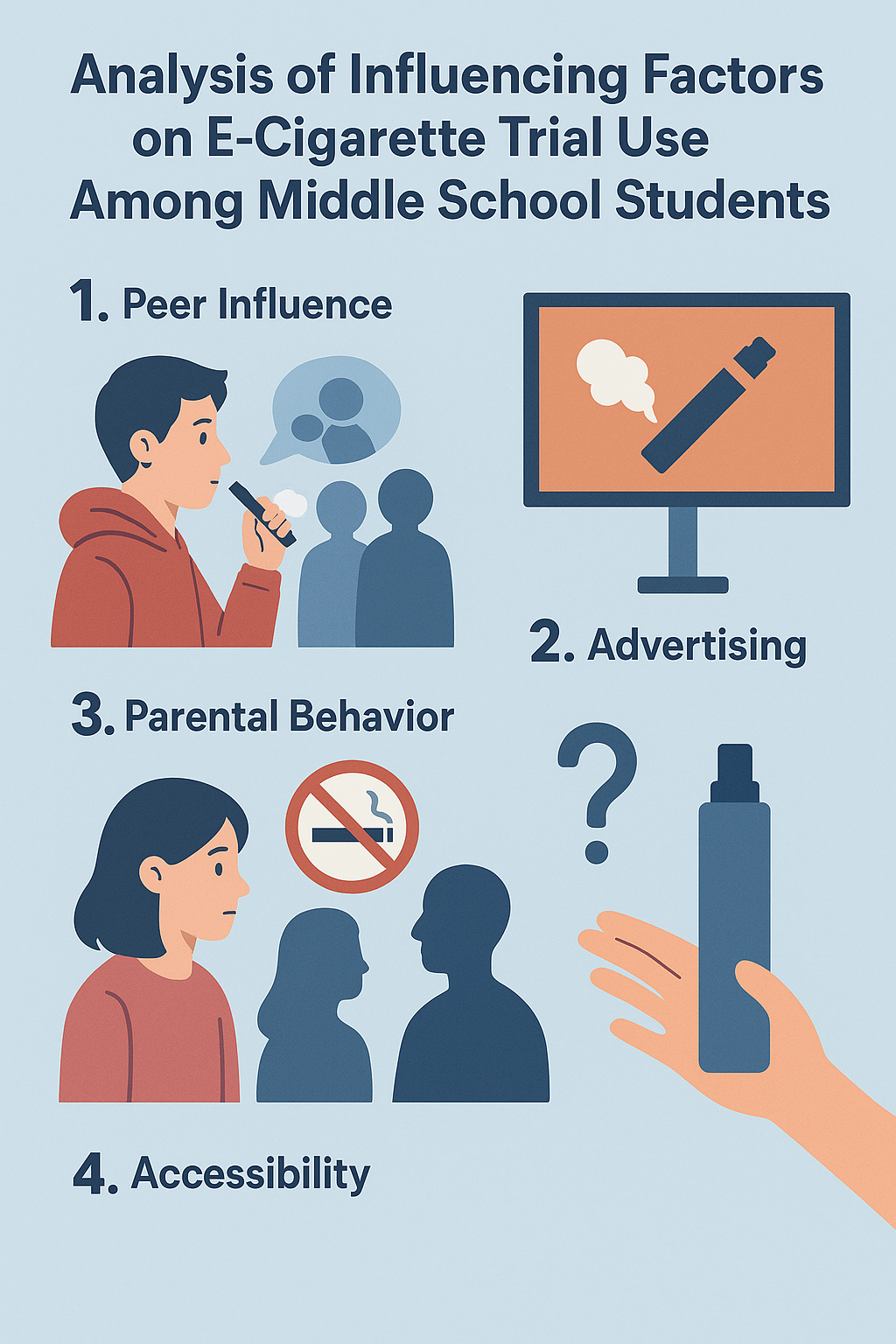
ARE YOU OF LEGAL VAPE AGE?
Please confirm that you are of legal age to purchase vaping products to access our site.

Please confirm that you are of legal age to purchase vaping products to access our site.
Some items are no longer available. Your cart has been updated.
This discount code cannot be used in conjunction with other promotional or discounted offer.
Abstract
Introduction
Methods
Results
Discussion
Objective: To investigate the prevalence of e-cigarette trial use among middle school students and its influencing factors, providing evidence for developing e-cigarette control strategies targeted at this population.

Methods: From August to October 2023, a multistage random cluster sampling method was employed to select middle school students from 12 schools across two counties (cities/districts) in Shaoxing City, Zhejiang Province, China. The "Youth Tobacco Survey Questionnaire" was used to collect data on demographic information, tobacco harm awareness, exposure to tobacco advertising and anti-smoking information, smoking status, secondhand smoke exposure, and e-cigarette trial use. Multivariate logistic regression analysis was conducted to identify factors influencing e-cigarette trial use.
Results: A total of 1,938 middle school students were surveyed, including 1,068 males (55.11%) and 870 females (44.89%). The prevalence of e-cigarette trial use was 3.46%, with the primary age of first trial being 12–13 years (22 cases, 32.84%). Multivariate logistic regression revealed higher odds of e-cigarette trial use among males (OR = 2.040, 95% CI: 1.066–3.907), students with pocket money (OR = 2.264, 95% CI: 1.294–3.963), current smokers (OR = 5.758, 95% CI: 1.649–20.107), those who believed smoking makes young people more attractive (OR = 3.211, 95% CI: 1.295–7.965), those without exposure to anti-smoking information (OR = 2.752, 95% CI: 1.526–3.963), students with smoking friends (OR = 7.662, 95% CI: 4.239–13.850), those who had seen teachers smoking (OR = 2.563, 95% CI: 1.072–6.124), and those exposed to secondhand smoke in indoor public places (OR = 2.179, 95% CI: 1.218–3.900).
Conclusion: E-cigarette trial use among middle school students is influenced by gender, pocket money availability, current smoking status, perception that smoking enhances attractiveness in youth, exposure to anti-smoking information, peer smoking, teacher smoking, and secondhand smoke exposure in indoor public places. These findings underscore the need for targeted interventions to curb e-cigarette use in adolescents.
E-cigarettes are battery-powered devices that convert a mixture containing nicotine and other substances into an aerosol for inhalation by users, with adolescents being the primary demographic. Youth tobacco surveys indicate a rising trend in awareness and use of e-cigarettes among middle school students. E-cigarettes pose significant health risks, adversely affecting the physical and mental well-being of adolescents, necessitating early school-based tobacco control interventions. Prior studies have identified factors such as cigarette smoking, perception that smoking increases attractiveness in youth, exposure to online tobacco advertising, male gender, peer smoking, and teacher smoking as influencers of e-cigarette use among middle school students. This study examines the prevalence of e-cigarette trial use and its influencing factors among middle school students to inform targeted control strategies.
From May to June 2025, a multistage random cluster sampling approach was utilized to select two counties (cities/districts). Proportional to population size, three junior high schools, two general high schools, and one vocational high school were sampled per county (city/district). One class (with at least 40 students) was randomly selected per grade, and all in-school students in the selected classes were included. The study was approved by the Ethics Committee of Shaoxing Center for Disease Control and Prevention (Approval No. 2023009). All participants provided informed consent.
The "Chinese Youth Tobacco Survey Questionnaire," developed by the Chinese Center for Disease Control and Prevention, was administered via an online platform on a class-by-class basis. The questionnaire covered:
(1) Demographic information, including gender, region, school type, and pocket money;
(2) Tobacco harm awareness, such as knowledge of secondhand smoke hazards, perception that smoking makes young people more attractive, and addictiveness of e-cigarette use;
(3) Exposure to tobacco advertising and anti-smoking information (within the past 30 days), including hearing/seeing anti-smoking messages, observing smoking in electronic media, witnessing smoking inside or outside school buildings, seeing tobacco product advertisements/promotions at retail points, encountering tobacco product ads/videos online, and viewing e-cigarette advertisements;
(4) Smoking status, encompassing current smoking, parental smoking (either parent), peer smoking, and teacher smoking;
(5) Secondhand smoke exposure in the past 7 days, in homes, indoor public places, outdoor public places, and public transportation;
(6) E-cigarette trial use details, including age at first trial and reasons for trial. E-cigarette trial use was defined as having ever tried e-cigarettes, even just one or two puffs; current smoking was defined as having smoked cigarettes in the past 30 days.
Trained investigators from each county (city/district) conducted the surveys and performed quality checks, correcting omissions, skip logic errors, and ensuring questionnaire completeness before upload.
Data analysis was performed using SPSS 20.0 software. Categorical data were described using relative frequencies, and group comparisons were conducted via chi-square tests. Multivariate logistic regression was applied to analyze factors influencing e-cigarette trial use among middle school students, with a significance level of α = 0.05.
A total of 1,969 questionnaires were distributed, with 1,938 valid responses recovered (effective rate: 98.43%). The sample comprised 1,068 males (55.11%) and 870 females (44.89%); 1,014 urban students (52.32%) and 924 rural students (47.68%); 1,054 junior high students (54.39%), 554 general high school students (28.59%), and 330 vocational high school students (17.03%).
E-cigarette trial use was reported by 67 students (3.46%). Higher rates were observed among males, urban students, vocational high school students, those with pocket money, current smokers, those unaware of secondhand smoke hazards, those perceiving smoking as making young people more attractive, those believing e-cigarettes are addictive, those without exposure to anti-smoking information, those observing smoking in electronic media, those witnessing smoking inside or outside school buildings, those seeing tobacco advertisements/promotions at retail points or online, those viewing e-cigarette ads, students with smoking parents (either), smoking peers, or teachers who smoke, and those exposed to secondhand smoke in homes, indoor/outdoor public places, or public transportation (all P < 0.05). See Table 1.
Four students (5.97%) reported first trial at ≤7 years old, with the majority at 12–13 years (22 cases, 32.84%). Curiosity was the primary reason (40 cases, 59.70%), and e-cigarettes were mainly obtained from classmates/friends (36 cases, 53.73%).
Using e-cigarette trial use (0 = no, 1 = yes) as the dependent variable and variables with P < 0.05 from Table 1 as independent variables, multivariate logistic regression identified gender, pocket money, current smoking, perception that smoking makes young people more attractive, exposure to anti-smoking information, peer smoking, teacher smoking, and secondhand smoke exposure in indoor public places as significant influencing factors.
This study found a 3.46% prevalence of e-cigarette trial use among middle school students, lower than the national rate of 8.3%. Urban students exhibited higher rates than rural ones, potentially due to greater e-cigarette accessibility in urban areas with widespread sales points. Vocational high school students showed elevated rates, consistent with prior research, likely attributable to increased social exposure and broader access channels. The low age at first trial highlights the urgency of early e-cigarette health education.
Males, students with pocket money, and those perceiving smoking as enhancing youth attractiveness had higher odds of e-cigarette trial use. Pocket money increases tobacco accessibility, elevating trial risks. E-cigarettes' trendy designs and diverse flavors appeal strongly to adolescents, compounded by limited harm awareness and curiosity, often influenced by advertising. Current smokers were more likely to try e-cigarettes, aligning with findings from Xu et al.and Qin et al, as tobacco addiction heightens acceptance of e-cigarettes. Lack of anti-smoking information exposure, peer smoking, teacher smoking, and indoor public place secondhand smoke exposure also increased risks, consistent with Shen et al. Environmental factors play a crucial role in shaping health behaviors, particularly during adolescents' formative years, where imitation is common.
Effective e-cigarette control among middle school students requires collaborative efforts from individuals, families, schools, and society. Recommendations include promoting health education to enhance awareness of e-cigarette and tobacco harms, fostering anti-smoking self-efficacy; creating smoke-free environments in homes, schools, and public places to reduce exposure; and strengthening regulations on tobacco advertising and sales to support adolescent e-cigarette control initiatives.

Comment